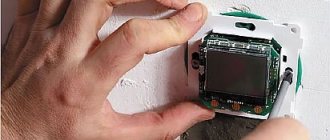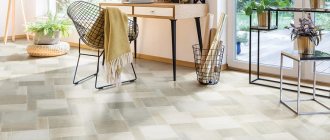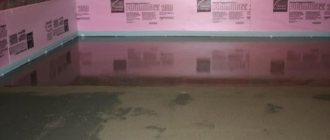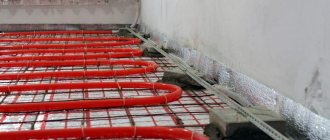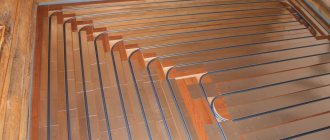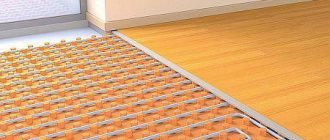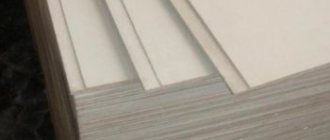The main advantage of ceramic tiles is the possibility of laying them on any of the existing heating systems: water or electric, since they have high thermal conductivity.
If the question is which type of heated floor is best to choose for tiles, then our answer is electric , because it is easy to install and does not put pressure on the ceiling like a water heating system.
Let's take a closer look at all floor heating devices used under tiles to find out which is better in each specific case.
Which manufacturer should you choose?
| Photo | Name | Rating | Price | |
| #1 | ERGERT® MAT EXTRA (ETME) | ⭐ 4.95 / 5 13 — votes | Find out the price | |
| #2 | Thermo | ⭐ 4.95 / 5 8 — votes | Find out the price | |
| #3 | Caleo | ⭐ 4.95 / 5 9 — votes | Find out the price | |
| #4 | Rehau | ⭐ 4.9 / 5 10 — votes | Find out the price | |
| #5 | Teplolux | ⭐ 4.85 / 5 12 — votes | Find out the price | |
| #6 | Energy | ⭐ 4.8 / 5 9 — votes | Find out the price | |
| #7 | Ensto | ⭐ 4.75 / 5 4 - votes | Find out the price | |
| #8 | Devi | ⭐ 4.75 / 5 10 — votes | Find out the price | |
| #9 | National comfort | ⭐ 4.75 / 5 3 - votes | Find out the price | |
| #10 | Unimat | ⭐ 4.7 / 5 1 - voice | Find out the price |
Which electric floor will you choose?
Take the survey
Ceramic tiles are one of the most common flooring options in homes, apartments, and offices. It is practical, beautiful, durable, easy to care for and durable. That is why it is so often chosen, especially for installation in rooms such as the kitchen or bathroom.
But tiles have one important drawback - due to their high thermal conductivity, the material always seems cold, and walking on it is not always comfortable. A heated floor system helps solve this problem. Experts advise choosing an electric one, since it can be installed in any living space, and during installation, some types of such systems can simply be laid under the tiles without making a new screed.
Below is a list of the TOP 10 manufacturers whose heating systems are most often purchased on the Russian market. Note that the rating is a subjective result of the work of the site’s editors and is based on an analysis of a number of stores and portals that publish ratings and reviews of consumers who have managed to use this or that product. You should not accept this list as the only reliable one - it may well be that you have your own opinion about a particular manufacturer. Nevertheless, we suggest that you familiarize yourself with our list of popular manufacturers, compiled on the basis of ratings and reviews posted online by real users.
Unimat
Unimat
This is the name of the brand, and the company Kaleo-Trade produces heated floors with this name. By the way, below we will also talk about Caleo IR floors, but they have taken one of the leading positions. Low price is the main advantage of Unimat, which is why heating systems under this brand are in demand.
As users note, Unimat products - and these are IR rod floors - are quite good. Indeed, it is inexpensive and heats well. The cable is equipped with good Teflon insulation and is well shielded, so protection against electric shock is at a high level. The cable itself is fixed on a mesh with an adhesive layer. However, it was noted that the systems are quite simple to install. Such heating is quite suitable for tiles - just lay it on the base, apply the tile adhesive composition on top and lay the coating itself, and then wait for it to dry. In addition, Unimat heating mats have overheating protection. In a word, it’s quite possible to buy if you want to save money and buy a more or less high-quality option. The downside is the fragility of stable work.
pros
- inexpensive option
- ease of installation
- suitable for laying under tiles
- famous company
- secure system
Minuses
- short-lived
Prices for Unimat heated floors
Warm floors Unimat
Reviews of Unimat heated floors
National comfort
National Comfort
This is a Russian brand, but you shouldn’t think that it produces low-quality heating systems. In general, this brand can easily give some foreign companies a head start. Moreover, its products are not even exorbitantly expensive. The brand belongs to a Russian group of companies whose headquarters are located in the Moscow region. The brand entered the market in the early 90s.
The company not only produces heated floors using a proven technology system, but also constantly improves its products. So the heating systems from National Comfort are getting better and better.
The materials used are of high quality, which makes it possible to talk about the durability and good functionality of heated floors. All products have appropriate quality and safety certificates.
Users note that they chose the flooring of this company most often because of the low cost. However, most of them were satisfied and can safely recommend the brand to their friends. Installation is quite simple and does not require special skills. Floors from this brand are also characterized by economical energy consumption.
pros
- Russian brand
- inexpensive option
- ease of installation
- suitable for laying under tiles
- quality materials
- secure system
Minuses
- not noted as such
Prices for heated floors National Comfort
Warm floors National comfort
Devi
Devi
A company from Denmark appeared on the market in the 40s of the twentieth century and since then has not lost its leading position among all manufacturers of floor heating systems. Previously, it produced heaters only for industry, but since the 60s it began to actively produce heating cables that can be used in everyday life. Some of the oldest electrical underfloor heating systems were created by Devi.
Devi products are trusted by many, and there is a reason for it: stability in the market, the reliability of the company, the opportunity to get a quality product. Now the company's products are represented in many countries, including Russia.
As users note, Devi floors are quite powerful, heat well, and are of good quality. Even the good packaging of the products is noted. The thermal mat has an excellent base. The company also provides a long warranty on its products - up to 20 years. But the price of heaters is already higher than in the previously described cases.
pros
- reliability
- one of the oldest companies
- high quality heating systems
- long warranty
- good product packaging
Minuses
- not detected
Prices for heated floors Devi
Warm floors Devi
Reviews of Devi heated floors
Ensto
Ensto
Another European brand, this time from Finland. Durable, high-quality, survivable and working perfectly in any conditions, underfloor heating systems are the pride of Ensto.
Ensto floors can be used with almost any floor covering, including installation under tiles. This is the optimal solution for almost any room. The systems are characterized by low energy consumption, ease of installation and use. And where would we be without Finnish quality! By the way, Ensto systems can be used even in particularly difficult conditions - for example, with high humidity or dryness in the house. They will still be effective. Some people use them even in unheated rooms and are satisfied with their choice.
Users note that the price of heating systems is quite flexible; it depends on the power of the heating mat. But in general, in the range of products, everyone will be able to choose the right option for themselves.
pros
- Finnish quality
- flexible cost
- systems can be used in difficult conditions
- low power consumption
- can be used in unheated rooms
- high efficiency
Minuses
- for powerful models the cost is higher than that of analogues
Prices for Ensto heated floors
Warm floors Ensto
Energy
Energy
A relatively young, but already becoming quite popular brand, which is beginning to win the trust of customers and is already included in the ratings of recommended manufacturers. Production is in the UK, and this already speaks volumes and, at a minimum, about English quality. By the way, the company recently began selling its products abroad.
Energy products meet the most stringent requirements and are made according to standards. Warm floors from the company are completely safe for humans and are of high quality. In addition, they are economical and effective. Such heating systems are simple to install, and after installation they can be either an additional or the main source of heat. Uniform heating of the floors allows you to achieve maximum comfort.
An important feature of the floor system is the special design of the heating cable. For its insulation, special modern alloys were used, which will not only protect a person from electric shocks, but also prevent the possibility of mechanical damage to the cable. The price for systems of this level is acceptable.
pros
- uniform heating of the floor
- excellent cable insulation
- protection of the cable from mechanical influences
- efficiency
- heating system efficiency
- compliance with all norms and standards
- made in UK
- Guaranteed service life - 20 years
Minuses
- not detected
Prices for Energy heated floors
Warm floors Energy
Teplolux
Teplolux
This is one of the most widespread and large companies whose products can be seen on the Russian market of floor heating systems. A domestic brand produced by Special Systems and Technologies. Such systems are sold mainly in the Russian Federation, as well as Belarus, Kazakhstan and other nearby countries.
All products are produced on automated and very high-quality equipment made in Europe. The assortment includes more than 400 types of cables. All products are of good quality and durable, and the systems can be used even in rooms with high humidity. It's simple - a two-core braided screen allows you to achieve a high level of wire insulation. The company also even produces a special adhesive composition designed for installing heating systems under tiles. This composition additionally protects the cables from various damages.
Warm floors can be selected for any room - there are a variety of options, for example, Teplolux Mini for small rooms or Teplolux Tropics for cold ones. The warranty is 20 years, and according to the manufacturer, the heating system is ready to work without interruption for 50 years.
Users note that the systems are reliable and efficient, they heat up quickly, and the floors also heat up in a short time. There are no disadvantages as such.
pros
- famous company
- durable systems
- fast heating
- efficiency
- safety
- long warranty
- special mixture for installing floors under tiles
Minuses
- not detected
Prices for heated floors Teplolux
Warm floors Teplolux
Reviews about heated floors Teplolux
Rehau
Rehau
One of the leading companies that almost everyone knows. The main production is located in Germany, and all systems are produced in accordance with European level quality and safety requirements. By the way, Rehau does not specialize in the production of electric floors: on the contrary, the range includes a fairly large number of water systems, as well as other various products for construction and repair.
Rehau floors are easy to install, comfortable and durable. All of them are created according to the company’s unique proprietary design and are heating mats with a two-core wire that has excellent insulation. The protection system is double, made of polymers that provide protection against temperature changes and resistance to deformation. Systems from this company can be installed even in conditions of low air temperature - +5 degrees. Even in this case, you don’t have to worry about damage to the protective sheath of the wires and its cracking. And when the mat is filled with mortar, no voids are formed under the tiles. Laying can be done without using a screed.
Users note that floor heating systems from Rehau are durable and reliable. They are considered by many to be the best, one of the most powerful, and they heat the floor and room well and quickly.
pros
- famous company
- German quality
- reliability
- durability
- can be installed in cool rooms
- good cable insulation
- with the correct installation technology, no voids are formed under the tiles
Minuses
- the price is higher than other systems
Prices for heated floors Rehau
Warm floors Rehau
Caleo
Caleo
We already mentioned this company in passing when we wrote about Unimat. It was Kaleo that created the budget heating systems described at the very beginning of the rating. Now let's talk about film floors that run on electricity and are produced under the Caleo brand.
Now film floors from Kaleo are the most common. They are easy to install, do not require complex preparation of the base surface and do not require pouring a screed. It was Kaleo, by the way, that developed the very first version of the film floor in the world, only then other companies began to use the technology. Despite the fact that the company entered the market only in the 2000s, it is already well-known and widespread. Buyers trust its products. All floors are tested for quality and safety and only then sent to the market. Also, all products have the appropriate certificates, at the European level.
As users note, the product fully corresponds to what the manufacturer says. Negative reviews on the Internet are extremely difficult to find, and for the most part they describe minor shortcomings of the systems - for example, the lack of wire to connect individual strips of the IR floor.
pros
- famous company
- Availability of safety and quality certificates
- production control from all sides
- the company was the first to develop IR floors in the form of film
- the most common heating option
- no need to fill the screed during installation
- product reliability and safety
- convenient installation
Minuses
- not detected
Prices for heated floors Caleo
Warm floors Caleo
Thermo
Thermo
Swedish floors, which deservedly occupy the first position in our rating. The company's headquarters is located in Stockholm, but in Russia it has its own enterprise, Thermo AB. The company entered the Russian market in the early 90s and actively participated in the formation of the underfloor heating segment in the Russian Federation.
The company offers a large selection of products and a sufficient quantity throughout the country. In addition to the heating elements themselves, it also produces all the necessary components for installing and connecting heating systems - all kinds of sensors, regulators, and so on. You can buy a wide variety of heating cables from Thermo, each option is optimally suited for use in certain conditions - for example, in rooms with a large or small area, and so on.
On a note! When choosing a floor from Thermo, it is enough to know only the size of the room and its general characteristics. And in the company’s catalog it is easy to find an already calculated option that is optimally suitable for a particular case.
Some heating options can even be used for objects that are located in the open air. So you can install a heated floor, for example, on the steps leading to the house, and not worry about the appearance of ice.
Users note that the floors do not have any particular disadvantages. They are easy to install, durable, and do their job well. The most important thing is not to buy a fake. Therefore, when purchasing, it is important to choose a good seller and request all supporting documents from him.
pros
- well-known company
- simplified selection of heating system
- can be used outdoors
- durability
- efficiency
- the most common option on the market
- wide variety of heating systems
Minuses
- there are fakes
Prices for Thermo heated floors
Warm floors Thermo
Reviews of Thermo heated floors
ERGERT® MAT EXTRA (ETME)
Warm floors ERGERT® MAT EXTRA (ETME) are ultra-thin two-core heating mats manufactured in compliance with European quality standards in factories in Germany. The EXTRA series is represented by two lines of heating mats with a power of 150 W/sq.m and an increased power of 200 W/sq.m, this will allow you to choose ready-made solutions for installing floor heating, both in heated and cold rooms with a high level of heat -losses.
Brand website: https://ergert.com.ru
ERGERT MAT EXTRA (ETME)
Unlike similar products from other manufacturers, EXTRA series heating mats have a number of technical features:
pros
- ultra-thin two-core heating cable with a diameter of 2.5 mm, securely fixed on a synthetic base with high adhesiveness;
- Today's best protection against overheating of heating cores using two-layer fluoroplastic insulation PTFE 270°C / PTFE 270°C;
- reinforcement and continuous shielding of the heating cable from electromagnetic radiation using tinned copper braiding, which has a significant effect on protecting the heating cores from rupture or mechanical damage.
- The reliability and quality of heated floors in this series is confirmed by a 50-year warranty from the manufacturer.
Minuses
- No particular disadvantages were found.
Electric heated floor ERGERT
Cable systems rating
Varmel Mini Cable 17-255 W
This heating cable can be installed both in an apartment and in a greenhouse.
It is made of two current-carrying cores with an armored shield and fire-resistant insulation (self-extinguishing effect). It can be freely laid under tiles or laminate. The declared power of this particular kit is 255 W. Operates from a regular 220 V socket. Please note that this bay contains 17 m of cable, which can be laid on the floor. However, depending on the scope of application, the laying step will change, and therefore the size of the heated area. On the floor of an apartment or house, on average, 7 linear meters of cable are used per 1 m2 of area in increments of about 9 cm. Therefore, in an apartment, the cable can heat up to 2.5 m2. In a greenhouse, the laying step will be larger, so this cable bay can heat up to 3.75 m2 of area. We recommend that you first accurately calculate the heated area in order to take the required number of coils without excess.
SpyHeat Classic SHD-15-300
A two-core heating cable from SpyHeat is designed to heat up to 2.6 m2 of apartment or house area. However, with good insulation, it can be laid in smaller increments, and then the heated area will increase to 3 m2. Its maximum power consumption is 300 W. The length of the cable in the bay is 20 linear meters.
A two-core wire with a cross-section of 4 mm is “clad” in a metal screen with high-quality fire-resistant insulation. The manufacturer claims that the cable system can last up to 50 years without repair. Please note that this coil comes with a grounding conductor. The length of the cold cable (the section that connects the heated floor to the electrical network) is 2 m. The cable can be used for both tiles and screed.
Caleo Cable 18W-120
This coil of heating cable is already designed to heat an entire room with an area of up to 16.6 m2. It can be laid under a 2–5 cm thick screed, under parquet, tiles or linoleum. For 120 meters of wire, the power declared by the manufacturer is 2160 W, which gives approximately 18 W per 1 linear meter. This is a good indicator for a product, cheaper than 80 rubles per meter. The current-carrying conductors have double insulation: the inner one is made of TPEE, and the outer one is made of PVC. Also under the PVC there is a layer of aluminum foil, which acts as a screen.
The total operating current of the entire bay (assuming the entire product is used) is 9.8 A, so a separate outlet will be required to connect it. The cross-section of the conductor here is 4 mm, and the resistivity is 22.3 Ohms. The manufacturer claims that the cable will last 50 years, but gives a 20-year warranty.
What type of underfloor heating is best to use under tiles?
Floor tiles are a material characterized not only by durability, practicality and beauty, but also by high thermal conductivity. That is, it heats up easily and cools down quickly, which is why floors covered with it are not always comfortable for walking on them, for example, barefoot. This disadvantage is especially acute in the off-season, when there is no heating in the house yet, but it is already quite cool outside. That is why previously tiles were laid on the floors throughout the apartment less often.
Now the situation has changed. It is now easy to get rid of the main disadvantage of tiled bases - high thermal conductivity - by installing a floor heating system under the finishing material. You just need to install it and then turn it on at the right time - and the tile will acquire a temperature that is comfortable for a person. The most common places for installing such heating systems are the bathroom, toilet, toilet, hallway and kitchen. This is where “cold” tiles are most often placed.
Installation of infrared floor
On a note! In some cases, the underfloor heating system acts as a heating system for the entire room or as an additional part of the heating system of the house. In the first case, the floors need to be installed on approximately 70% of the entire area of the room and with small gaps between the heating circuits.
The configuration of the floor heating system depends on how it works and what type of heating element it is. You can purchase and install floors that run on water, as well as electric ones, which are divided into several types. Let's get to know them.
Water heating systems
Previously, this was the most common option for underfloor heating in private homes. This heating system is a heating circuit laid according to a special system in the floor screed, that is, a polypropylene pipe, which is securely fixed to the base and then filled with cement screed. To heat the floor covering, water is used as a coolant. It is supplied from the central heating system, if it is possible to connect to it, or from the heating boiler in the house.
Water heated floor
Attention! In apartment buildings, water floors cannot be installed, with the exception of apartments that have special outlets from the heating system designed to connect a heated floor. In other cases it is prohibited!
A water floor is economical and is suitable for installing heating systems in a private home. Installation, by the way, is quite troublesome, but not so expensive. But it’s worth thinking about installing a water floor at the construction and renovation stage. The fact is that such a system can only be installed in a screed. And this is dirty and time-consuming work. Only the screed should dry for almost 30 days! But some modern options for water heating can be installed without a screed, using special heat-distributing plates instead.
Electric heating systems
For electric heating systems, as you might guess, the source of heat is electricity, which is directed from the power supply system to heating cables, mats or infrared floors. And here you can note for yourself the main obvious advantage of this option: such floors can and even should be installed in absolutely any premises, including in apartment buildings! No approvals from the management company, no fears for leaks and no plumbing work related to heating pipes - just opt for electrics, and you already have a heated floor in your home without any restrictions. Another advantage of such a heating system is the ability to accurately regulate the temperature, down to 1 degree, which is not possible with the quickly cooling and long-heating coolant water in the water heating modification.
Table. Types of electric floors.
| System type | Description |
| Cable | This option is a long cable of a special type - heating. It is capable of converting ordinary electricity into thermal energy. This is a durable and reliable option that consumes relatively little electricity, but has high heat dissipation. The main disadvantage is the need for installation in a screed or using special materials, as for water floors. Because of this, the thickness of the base can be significantly increased. The cable can be resistive two-core or single-core. There are also special ultra-thin cables on sale that have a high level of electrical resistance. Any of them must have good insulation to avoid electric shock to the residents of the house. The installation diagram of the cable system is very similar to the diagram of the water heating system. The only difference is in the type of coolant. Most often, cable floors are used, like water floors, in private homes. They are great for complex layouts. |
| Heating mat | This option is more common than cable and is often laid under ceramics. It looks like a thin cable attached to a sheet of fiberglass reinforcing mesh. This is a thin version of the heating system that can be installed without worrying about raising the floor level. Unlike a cable system, this type is more reliable, since in the event of a breakdown, you do not need to change the entire cable, but just replace the damaged section. You also don’t have to completely disassemble the floors—the main thing is to identify the defective area. Installation of the system is extremely simple, and with modest electrical knowledge, you can install such floors even without the help of a specialist. But this option costs more than cable. You can use the floors after installation just a few hours later, as soon as the tile adhesive has hardened - no screed is needed. The mats must not be cut, so the heating area of the room will have to be calculated in advance with high accuracy. Also, they should not be placed where heavy furniture will be placed - overheating and breakdown of the system is possible. |
Heating mats under tiles
Infrared film
The IR film is made in the form of mats, the thickness of which is no more than a millimeter, on both sides there is a layer of heat-resistant polyester, and between it there are carbon strips connected by copper busbars, they carry out the heating function.
Infrared film can be laid under different surfaces, even under parquet. First, the floor covering absorbs infrared radiation, after which it transmits it to the environment. Infrared film is afraid of moisture, so it is not recommended to install it in a screed or under tiles.
The heat generated by the cable or mat is retained longer in the screed or in the adhesive layer, so the thermostat can periodically turn off the power from the network and thus save energy.
Video - Video review of electric heated floors
Infrared floor
We will consider infrared heating options in a separate section. This is another type of underfloor heating where the energy source is electricity. And it can be called the most popular and modern.
This system is a fairly thin film that spreads under the floor covering. There is carbon paste (hardened) on it or bimetallic elements (copper and aluminum) are installed, which generate heat - this is the heating element. Heating of the room occurs due to infrared radiation. Each film module has dimensions of 50*50 cm, but it is supplied in rolls. All pieces of film just need to be connected to each other to get a single system and connect it to a current source.
Infrared floor
Infrared floors are easy to install and very effective. They can be used with absolutely any type of flooring, including ceramic tiles. Electricity costs are minimal - this is the most economical option for floor heating. Other advantages include the absence of the need to equip a cement screed, the ability to cut the film on site to a certain size (along specially marked cutting lines), the chance to adjust the heating with high precision, simple installation, uniform heating, and quiet operation. The main disadvantage of the system is its relatively high cost.
Important! When installing an infrared floor under tiles, it is important to use a reinforcing mesh between it and the tile itself.
The IR system is installed on a ready-made base, on which a thin heat reflector is already laid. Next, you just need to lay down the heating film, connect all its elements, connect to the sensors and power system, and then, covering it with a reinforcing mesh, simply lay the floor covering. A prerequisite when laying the film is to avoid overlaps and fix it to the base using regular tape to avoid the appearance of these overlaps in the future if the system moves. The intersection of individual panels with each other is detrimental to the system and will easily lead to its damage.
On a note! IR floors do not emit electromagnetic radiation around themselves and are much safer for human health than other options.
There are masters who are opposed to laying IR floors under ceramics. They explain the refusal of this option in this case by the fact that the film itself has low adhesion, and adhesion to the tile will be poor. But in fact, if the installation is done correctly, then the sliding effect is quite possible to avoid. It is also important to use certain adhesives during installation - not all standard tile adhesives are chemically inert and some can damage the film.
The best heating mats
STN Square
The Russian-made heating mat has a cross-section of current-carrying conductors of 3.5 mm. Its size is 200x50 cm. If desired, it can be “rolled” not only into tiles, but also into a cement screed. Such a piece of mat is enough to heat 1 m2 of area, therefore, to heat a room of at least 10 m2 in size, you will need 10 pieces of such mats. You can order from the manufacturer not in pieces, but in a whole roll, so as not to combine.
The rated power of this product is 150 W. There is a grounding conductor here. Please note that in the mat the cable pitch is 10 cm - quite wide considering that the cable is usually laid in 7-9 cm pitches. The total thickness of the mat is 4 mm. The declared service life from the manufacturer is 20 years.
Electrolux EEM 2-150-1
The Electrolux heating mat has the same dimensions of 200x50 cm as STN Kvadrat. It also heats approximately the same area of 1 m2. But its price is almost 1000 rubles more expensive. Such a high price at first glance is due to the excellent quality of workmanship.
According to customer reviews, this heated floor has never failed. The manufacturer guarantees its normal operation for 20 years.
The mat consists of a polymer mesh and a two-core heating cable with a core cross-section of 4 mm. There is an aluminum screen inside. The entire mat produces a current load of approximately 0.68 A. This figure is worth taking into account if you plan to connect several mats to a single outlet. It also has an overheating prevention feature. We can say that Electrolux EEM 2-150-1 is the best electric heated floors for the money.
Warmstad WSM-100-0.65
This is a small electric mat for laying under tiles or porcelain stoneware. The model is quite small in size (130x50 cm) and can only heat up to 0.65 m2, but you can buy several rolls for your room. With this size, the mat has a power of 98 W. This is approximately 150 W/m2.
The design of the electrical mat requires the presence of a grounding conductor. If the outlet does not have a ground connection, then it will need to be installed permanently. The manufacturer promises that the floor will last 50 years, but gives a guarantee of 15 years.
Which heated floors are better for tiles?
Electric heating is the best option for a system installed under the tile. It is invisible, does not add excessive thickness to the floor, and is quite easy to install, depending on the type. There simply cannot be any leaks if electric floors are installed in the house. Heating is uniform and economical, and even capricious tiles will always be comfortable.
Important! The more powerful the system and the larger its area, the greater the energy consumption. But in general, all electric floors are quite economical.
Power of underfloor heating
When selecting an electric heating system, it is important to pay attention to several parameters. One of them is the required power and the conditions created in the room where installation of base heating is required. Typically, the power depends on how the room as a whole is heated, its area and purpose. For example, for an ordinary living room with heating, floors with a power of up to 120 W per meter are sufficient. And where there is high humidity, the power should be higher - around 150 W per square meter. If floor heating is the main one, then the power indicators can be increased even more - up to 220 W per square meter.
When selecting a heated floor and choosing its power, you need to take into account the places that will be filled with furniture. Laying a floor under them is not only not recommended, but also impossible. Air circulation in these places will be disrupted and the system may overheat and fail. On average, for a comfortable stay it is enough to warm up to 70% of the free surface of the base.
Advice! In the kitchen area or living room, the floor power, in general, may be lower than in the bathroom or on the loggia. It is also recommended to buy slightly more powerful options when installing underfoot heating on lower floors.
You can calculate the required power yourself using special calculators and formulas, or you can also seek help from consultants in the store where you purchase the heated floor. Some manufacturing companies immediately indicate in their catalogs certain indicators for certain conditions, and it is quite easy to navigate them and make the right choice in your case.
If we talk about the type of electric heating system, then under the tiles you can choose any option that you like and seems more convenient and effective, even IR flooring. In the latter case, you just need to take into account some installation features. Also, one more rule applies to IR flooring when laying it under tiles: you need to buy carbon floors. There are also bimetallic options, but they are not suitable for installation under ceramics.
As for the manufacturer, you need to choose one whose products satisfy you in all respects, and also fall within the budget allocated for the purchase of heated floors. There are good inexpensive options, some of them are presented in the rating above, and there are also expensive premium systems. The latter are distinguished by high performance in all respects, as well as durability. But even among budget options there are systems that, with proper installation and careful use, will last for many years without complaints.
Recommendations from experts
You can build a warm floor yourself. It is preferable, of course, to have at least basic knowledge in this area. After all, for example, the same infrared film requires proper connection. Although some systems are easier to deal with.
Regardless of whether the floors are made with your own hands or workers are invited to do this, there are a number of tips that will help carry out all the work efficiently. So:
- you need to understand that not the entire floor will be heated, but only those areas where there is no furniture or other interior items - approximately 60-75% of the total area of the room, which means that the material is purchased at exactly these percentages;
- before laying tiles, you need to double-check the serviceability of the system, especially if mats were installed (they may be twisted, broken, or even have breaks);
- after all the elements are put in place, you need to “ring” and double-check the joints of each section of the floors - it is cheaper to fix the damage before the finishing coating is installed than to then make repairs not only at your place, but also at those of your neighbors below;
- Under no circumstances should you walk on laid heating mats or place or throw any heavy objects on them until the tiles are laid;
- if the repair is not yet completed, then you need to mark the “path” of all cables, so that in the future it doesn’t happen that when drilling walls (for example, under shelves), you get into a wire;
- if a cable floor is being installed, you can turn it on for testing only after the screed has completely dried (drying time depends on the mixture);
- when working with infrared film, it is imperative to use a substrate with heat-reflecting properties - experts recommend using a rolled technical cork (2mm thick);
- before fixing the infrared film, you must first lay the mounting fiberglass mesh (mesh size - up to 3cm);
- to select the power of the thermostat, you need to carry out the following calculations - 150 multiplied by sq.m. heated area;
- for convenient operation and repair (if such a need arises in the future), it is recommended to use installation cables of different colors;
- if the infrared heating system outputs more than 2W, then you need to use a connection through a special machine.
These tips were compiled by professionals, which means they are tested by experience. Therefore, if you plan to create really high-quality heating, then you should listen to them.
Video - Electric heated floor under tiles
The optimal solution for all floor coverings in the apartment would be to install an infrared floor heating system or thermal mats. It is better to leave cable options for a private house. If we talk about manufacturers, then almost every company produces some specific type of heating system, however, options are not excluded when one company in its assortment can find a variety of base heating options. In any case, it is up to the owner of the house or the occupant of the room to decide which system to install. The recommendations in this article are worth listening to, but you should not use them as the ultimate truth. The information is provided for general information purposes only.
Installation of water systems
The principle of arrangement is the same as in the case of the electrical analogue. However, there are some differences. So, select communications with a diameter of 2 cm.
Near load-bearing walls and window openings, pipes are laid more densely (the width of this strip is 1 m).
To operate the system, a collector is provided. This is a complex design consisting of components necessary for correct operation: thermostat, thermostat, pump, pressure stabilizer.
